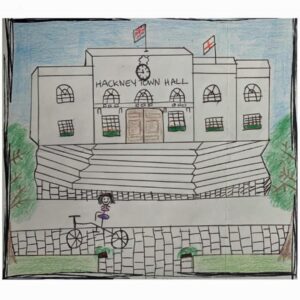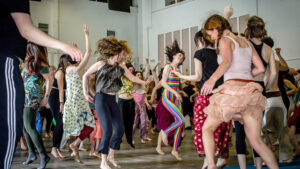
Local Business Fair returns
It’s the place to find out how you can get involved in the big summer festival activity in Victoria Park
It’s said that the celebrated photographer David Bailey’s grandmother collected glasses there and was paid in gin. Certainly printers, mechanics, scrap metal merchants and more all bowled into it before its closure in the mid-90s. Then all-night ravers and partyheads found more discrete ways in until the door was breeze-blocked a few years back. An organiser from that era, Kristian Dabiere, said: “Words can never do it justice. It was like the Wild West, an oasis of lawlessness in a derelict London backwater. Everyone who went there will have a story of some kind.”

When it comes to writing about the history and reopening of the Lord Napier pub, there’s no shortage of good material. The defunct boozer’s iconic street art status is well documented and people in the street all have their opinions. Search online and in the ranking you will find its distinctive current frontage hot on the heels of the Scottish noble who gave his name to it. Numerous magazines have covered it, with Huck referring to it as a palimpsest for the area.
A friend experienced his first ever rave there; the bits he can remember, he’ll never forget. In the middle of a welcome-to-the-Wick spiel on one of my own guided walking tours, I watched as blinking figures wobbled out into the morning sun, warm tins of lager in hand. The pub’s cultural, historical and even psycho-geographical symbolism is under no doubt. But as ever here, change is coming. There is a sense of excitement and optimism about the idea of having an actual pub amongst people I canvased, but two questions dominate the discourse: “Is it going to be ‘gastro’?” and “Will the street art be staying?”
Rob Star is the man behind Star Pubs. Originally from Leicester he’s been in the East London nightlife scene for 20 years. The reopening has been a long time coming. He’s been talking about this project with building landlord and local printer Stewart Schwartz for six years.

“He’s had lots of other offers but we’ve done our deal pretty much on a handshake and credit to him he hasn’t given it to a pub company that would have given him more money.”
Star smiles wryly as I ask the questions he’s so familiar with now: “The inside was all gone so it won’t be a recreation, but by no means will it be a gastropub. It’ll have comfy chairs, decent food and good beer. We’re going to spend a bit of money but we want a modern day traditional boozer with a central bar, welcoming to everyone in the area.” In his other pubs a burger or a Thai curry are typical fare and most takings are ‘wet’ sales. It’s hard to strike the right balance between multiple demographics, he says, but he hopes the pub will do that.
Star’s relationship with the Napier goes back to the noughties when he began warehouse parties in Brick Lane, then ran nights on what is now redeveloped as the Queen Elizabeth Olympic Park. He had it written into the Napier’s planning application that the exterior will still be a street art canvas: “I’ve got a guy who is part of the team that did the current design and he’s going to organise with other people here to give it a re-rub.” He speculates that it might well receive some unofficial updates too.

Edwin’s huge “Shithouse to Penthouse” slogan was part of a 2016 protest work against gentrification curated by local artist Aida Wilde. It may go, Star says coyly, but equally it may morph into something new. Wilde confirmed she would prefer that the existing gesture of resistance is not part of the new iteration.
Above that now-infamous graffiti, ZCD Architects have created two roof terraces while at street level the exterior glazed bricks were already peeking through hoardings in May. Stewart Schwartz bought the pub in 2004 when he had the idea that Hackney Wick would become a “printer’s paradise”. The man behind Schwartz Wharf and other properties says he bought into Hackney Wick when nobody else was interested because he believes in the area. He makes a point of never selling and is known for his informal agreements: “I’m inundated by offers from breweries who want to buy it, but I shook hands with Rob and my word is my bond.” He remembers the Lea Tavern (pictured below) that once stood on Whitepost Lane and the original Lord Napier too: “It was pretty basic, more like someone’s front room really.”

Schwartz is unequivocal that Hackney Wick is better now than it was, and many older East Londoners echo the sentiment that this was not a place to come and visit. Factory lives were hard, tin baths and outside loos were in use in the 1960s if not later. But others will recall a friendly pub in a tough but churchgoing area, even if it was segregated along gender lines; workers unwound and marriages were made. Sometimes the strains of Danny Boy would echo through the bar as those pipes called the Irish contingent. It’s always worth remembering that the Wick has been through multiple iterations, and estate clearances meant population changes.

Whatever happens, the new Lord Napier will be watched, evaluated and commented on. It’s another high-profile marker of change, like the opening of Sainsbury’s (see p10). But a common refrain – about the revamped boozer that was close to becoming more flats – is that it’ll be nice to have a proper pub.
Star hopes that soon we can once again sit down at a table that’s not ours and chat to a stranger we just met. Hopefully by July, on a corner where Hackney and Tower Hamlets rub shoulders, we’ll be able to do that once more – friends old and new, down the pub.

It’s the place to find out how you can get involved in the big summer festival activity in Victoria Park

Cyclists want Caroline Woodley to make the borough even more friendly for two-wheeled travel

When an area changes as rapidly as Hackney Wick today, it can place a range of stresses on our wellbeing. But help is close at hand
A joint venture in collaborative local media from:


In partnership with

Regulated by IMRESSS, the IndependentMonitor for the Press CIC.

For more info on our complaints policy, or to make a complaint, please see our FAQ.